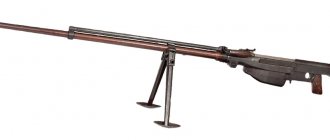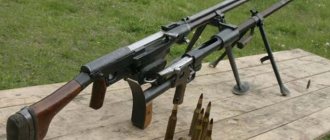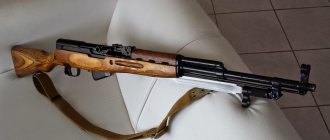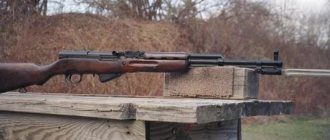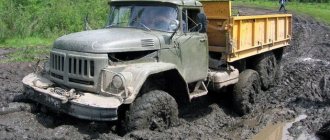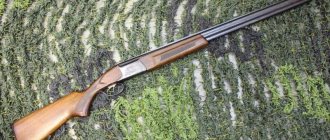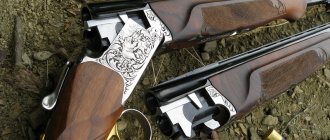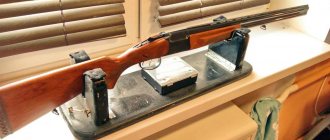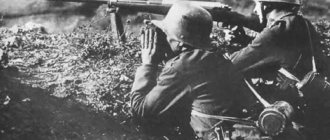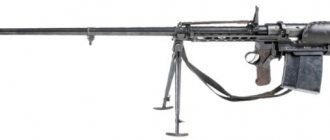PTRS - Simonov anti-tank rifle PTRS - Soviet self-loading anti-tank rifle of the Simonov system. It appeared in the troops soon after the start of the Great Patriotic War. Until 1943, the USSR needed to fight the armored vehicles of Nazi Germany by any means necessary, and anti-tank rifles during this period became almost uncontested weapons in terms of effectiveness.
The PTRS was intended to combat enemy medium and light tanks and armored vehicles at distances from 100 to 500 meters. In addition, such guns could fire at fortified firing points (pillboxes and bunkers), as well as at aircraft.
History of creation
The unsuccessful start of the Great Patriotic War for the USSR led to the fact that already in July 1941 I.V. Stalin set the task of arming the Soviet troops with a mobile and powerful means of combating German tanks. On the eve of the war, a large-caliber 14.5-mm cartridge had already been created in the Soviet Union, with which an anti-tank rifle (ATR) designed by Nikolai Rukavishnikov was tested. This gun was superior to the foreign analogues available at that time, but the complexity of its design did not allow for its rapid and mass production, especially in the conditions of such a difficult war.
According to the memoirs of D.F. Ustinov, one of the leaders of the Soviet defense industry during the war, Stalin at one of the first meetings of the State Defense Committee proposed entrusting the development of more technologically advanced 14.5-mm anti-tank guns, for reliability, to two designers at once. Vasily Degtyarev and Sergei Simonov received this task at the beginning of July 1941.
Samples of new weapons ready for testing appeared in the shortest possible time: only 22 days passed from setting the task to the first test shots. Both samples presented at the same time were successfully tested, on August 29, 1941 they were adopted by the Red Army and put into mass production under the names PTRS and PTRD. The decoding of these abbreviations meant, respectively, Simonov and Degtyarev anti-tank rifles of the 1941 model.
When creating the gun S.G. Simonov decided to take as a basis the design of his 1938 model self-loading rifle, which had already proven itself in battle. This required a noticeable increase in the dimensions of the weapon to such a size that it became possible to use 14.5 mm caliber cartridges. In general, it was this idea that was implemented, which made it possible to make the new anti-tank rifle self-loading, and to increase its practical rate of fire to 15 rounds per minute.
In comparison with Rukavishnikov’s self-loading anti-tank rifle, Simonov’s development showed similar results during testing both in terms of ballistic characteristics and weight-dimensional parameters, as well as in armor penetration and magazine capacity. At the same time, the PTRS showed higher survivability and was also easier to operate and maintain. It turned out to be noticeably more technologically advanced in production. In particular, the number of parts in Simonov's gun was one third less than in Rukavishnikov's gun.
Compared to Degtyarev's version, Simonov's anti-tank rifle was one and a half times faster-firing, but at the same time heavier and more difficult to manufacture. And in those days, as many guns as possible were needed, and most importantly, they were needed immediately. Serial production of PTRS began in November 1941, but by the end of this year only 77 of them were produced.
The delay in the release of PTRS was also due to the fact that they were planned to be produced in Tula, but after the evacuation of this production to Saratov, their production was soon established there at the former. Moreover, in order to quickly organize production, the production of the magazine box was entrusted to the combine plant, and the striker was entrusted to the mechanical workshops of the local university.
The second place for the production of PTRS was Izhevsk, where PTRDs were also made at the same time. For this purpose, evacuated production facilities of the Tula Arms and Podolsk Mechanical Plants were used. In the summer of 1942, the production of anti-tank rifles of both systems was separated into an independent plant No. 622 (later Izhevsk Mechanical Plant), and from mid-1943 this enterprise produced only PTRS.
The peak production of these weapons occurred in 1942-1943, when the role of anti-tank rifles in the anti-tank defense system was most significant. The production of PTRS in Saratov continued until June 1944, in Izhevsk - until December of the same year. A total of 190,615 PTRS units were produced during the war years. Subsequently, a significant number of PTRS were supplied by the Soviet Union to the DPRK and China; they were actively used in the Korean War of 1950-1953.
Sergei Simonov (center) during testing of the modified PTRS (August 1943)
On the effectiveness of firing from anti-tank rifles
Home » Real story » History of Wars » On the effectiveness of firing from anti-tank rifles
History of Wars
Leopold 01/05/2021 2467
18
in Favoritesin Favoritesfrom Favorites 7
With the beginning of the Great Patriotic War, it was urgently necessary to provide the troops with sufficiently mobile and long-range anti-tank weapons. The choice fell on 14.5 mm anti-tank rifles, which were developed in the shortest possible time by famous Soviet designers Vasily Degtyarev and Sergei Simonov.
Degtyarev developed a single-shot rifle (PTRD), and Simonov developed a self-loading rifle with a magazine for five rounds (PTRS).
Each had its own advantages and disadvantages, the PTRD was lighter and easier to use, and the PTRS had a higher rate of fire.
Both guns were put into service in 1941 and went into production at the end of that year. Mass production of PTRD was launched in 1941, and PTRS in 1942.
This type of weapon had the greatest effect on the battlefield in the period from 1942 to 1943, when the German Wehrmacht was armed mainly with light and medium tanks.
It is known from reports and combat reports that anti-tank rifle units were used taking into account the conditions of the combat situation, mainly from ambushes and shelters; below are excerpts from the reports of the 6th Guards. armies of the 1st Baltic Front and 22 armies of the 2nd Baltic Front on the combat use and effectiveness of firing from anti-tank rifles of the Degtyarev and Simonov system:
- in 1942, the PTR company of the 47 OIPTD in the area south of the city of Mozdok, organizing an ambush, managed to destroy 12 enemy medium tanks;
- in 1942 in the Staraya Russa area, a PTR platoon managed to knock out 3 tanks, having first passed them through their positions, and then from a distance of 400-500 meters hit the rear of the tank, where the engine compartment was located;
- in July 1943 in the battles in the Belgorod-Kursk direction, the PTR company of the 156th Guards Regiment (6th Guards Army), which had 12 PTRs, repelled an attack by 15 medium and light tanks, of which six light tanks were knocked out;
- 30.7.43 in the village area Torona, Stalin region, a platoon of PTR 31 OIPTD consisting of 6 guns knocked out 5 medium tanks (fire was fired on the sides);
- in 1943 in battles on the Molochnaya River (Ukrainian SSR) by PTR units of the 3rd Guards SD. 5 light tanks, 4 armored vehicles and 2 armored personnel carriers of the enemy were shot down and burned;
- in October 1943 in the area of Melitopol (Ukrainian SSR) from the attacking 12 tanks (4-T-4, 6-T-3, with the support of 2-T-6), a company of PTR 265 OIPTD, from a distance of 200 meters it was 6 tanks were hit, but the report did not indicate where the hits were.
Also in the report of the 6th Guards. The army noted isolated cases of the effectiveness of firing from anti-tank rifles at enemy aircraft:
- in September 1942 in the Kletskaya area (Don Front) from the PTR of the Guards. Sergeant Korolev shot down two enemy Yu-88 aircraft within 15-20 minutes at an altitude of 500-600 meters when exiting a dive;
- in September 1943 in 122 rifle regiments. an enemy plane was also shot down with an anti-tank rifle (the name of who shot it down was not indicated).
It was also noted in combat reports that the most effective PTR fire was on open, unarmored targets, on heavy machine guns and guns under direct fire, these targets were hit from a distance of 600-700 meters, using this method when conducting defensive battles in the Crimea 995sp armor-piercing guns .268 sd. managed to destroy up to 10 machine gun points and 2 direct fire guns.
The effective use of anti-tank rifle units was also noted after 1943, so from the report of the chief of the operational department of the 22 Army headquarters it is known that PTRD-PTRS continued to be effectively used in the second half of the war, but mainly as a means of suppressing and destroying enemy firing points located in houses and other shelters, so in the battles for the city of Krustpils (Lat. SSR) the advance of our infantry was hindered by machine guns installed in the windows of wooden buildings, anti-tank guns were used to suppress them, from a distance of 500-600 meters the guns showed all their fire efficiency, breaking through the walls of houses, hitting the enemy along with his materiel, a total of 8 machine gun points were destroyed.
PTRs were used especially effectively against enemy armored personnel carriers, as in August 1944. in the Shauliai direction armor-piercing troops of the 11th Guards. CK, using the BS-41 bullet, knocked out 27 enemy armored personnel carriers, thereby depriving the advancing German tanks of mobile motorized infantry.
The quite effective use of anti-tank rifles against tanks continued, as in the summer offensive battles of 1944. in the Turovlyanka region (BSSR), PTR units knocked out 7 light and medium tanks (the hit points were not indicated in the report) and 9 enemy armored vehicles.
PTRs played a major role in securing an occupied line when direct fire artillery was absent or delayed, thus, PTRs replaced 45 mm guns for direct infantry support, as well as for performing special fire missions, where it was impossible to place an artillery gun for direct fire due to -due to terrain features or enemy opposition. As it happened in the area of the village of Luzmano, where the advance of our infantry was hampered by a well-camouflaged tank, the enemy tank was set on fire with anti-tank guns.
Quite often, anti-tank rifles were used in anti-tank ambushes, so in January 1944. during the offensive operations of the 47th Infantry Division. (6th Guards Army) four anti-tank tanks were sent into an anti-tank ambush, the enemy launched a counterattack with the support of light tanks, the anti-tank rifle was repelled by sudden fire from a distance of 300 meters, and three enemy tanks were set on fire.
In the battles on the approaches to the city of Polotsk, two rifle companies were thrown behind enemy lines in order to cut off the enemy’s escape routes; the terrain did not allow the use of anti-tank guns; instead, the companies were assigned a platoon of anti-tank guns, which burned two lungs from a distance of 150-200 m with group fire enemy tank.
In the battles in the Beshenkovichi region (BSSR) PTR units of the 71st Guards Rifle Division. by going behind enemy lines, using group fire, consisting of 6-9 anti-tank rifles, a large number of firing points, armored personnel carriers, vehicles and other targets were destroyed.
PTR units of the 29th Infantry Division. (6th Guards Army) for the period from 26.6 to 1.9.44, while fighting against enemy firing points, individual rifles and groups of anti-tank rifles were destroyed up to 30 machine guns, a significant number of enemy vehicles and armored personnel carriers.
In the second half of 1943, by the beginning of the Battle of Kursk, the enemy began to receive heavy tanks and self-propelled guns with enhanced armor protection, as a result of which the role of anti-tank rifles on the battlefield sharply decreased. Although during experimental firing from an anti-tank rifle at a captured T-5-Panther tank, 3 BS-41 cartridges were fired from three guns each from a distance of 150 meters, as a result, 100% of through holes in armor 35 mm thick were noted when firing According to the T-6-Tiger, only one track link was damaged from the PTR, and then only from the fourth shot. However, the tests were carried out under ideal conditions, but in real battle conditions this type of anti-tank weapon could no longer effectively withstand the new German armored vehicles.
So, in the report of the headquarters of the 6th Guards. army from 09.25.44 about the effectiveness of using PTRD-PTRS, examples are given of the low effectiveness of PTR not only when firing from them at heavy tanks, but also at medium ones, since the number of hit points for this armored vehicle is very limited, even hitting the caterpillar did not bring much harm to it and only in In rare cases, it damaged the caterpillar, and even then, only on a medium tank.
In defensive battles in the Belgorod-Kursk direction on July 5-7, 1943. The enemy used heavy tanks in large numbers, but anti-tank rifles turned out to be powerless in the fight against them.
In the battles in the Usvey region (BSSR) in January 1944. units of PTR 67 Guards. sd. Not a single enemy tank was knocked out, although tanks were hit, but due to their low penetrating ability, even medium tanks were not put out of action.
In the battles in the Kruopiai area (Lithuanian SSR) on August 28, 1944, the enemy threw up to 20 heavy tanks into the attack; the anti-tank rifles, being in infantry combat formations, were unable to knock them out or set them on fire. After the battle, when inspecting the damaged tanks, it was found that despite the large number of hits from anti-tank rifles, the latter did not make a single hole in the armor of enemy tanks.
In the battles in the Shauliai direction in August 1944. PTR unit 16 lit. sd. Up to 30 shots were fired at the Tiger tank from a distance of 150-200 m, but the tank did not suffer any damage. In the same battles, the PTR company of the 5th Guards Regiment. 3rd Guards sd. fired twice at enemy heavy tanks, hits were observed, but there was no effect.
PTR crews operating directly in infantry combat formations represented a fairly visible target and were quickly exposed to enemy fire.
So, in 1943, in battles in the Saur-Mogila area, PTR units of the 3rd Guards. sd. in one hour of battle, 10 crews were lost completely and two crews lost one person each out of a total of 18 crews.
In the battles in the Sesiki area (Lithuanian SSR), out of 5 PTR crews, 3 crews were disabled in 40 minutes of battle.
The PTR crews of both systems, due to the bulkiness of their weapons, could not freely maneuver on the battlefield; the crew, consisting of two people, was unable to carry a sufficient amount of ammunition, as a result, firing was often limited by the availability of ammunition.
The report of the operational department of the headquarters of the 22nd Army indicated significant shortcomings that were revealed in the anti-tank rifle of the Simonov PTRS system, so in the Krieviciems area (Lat.SSR), during an enemy counterattack from August 12 to 13, the PTR company of the 319th sp. 308 latv. The SD was armed, mainly with rifles of the Simonov system. When the enemy fired from mortars, from the sand raised by mine explosions, all PTRS guns refused to reload, while Degtyarev's PTRD guns continued to fire.
In the Rushani area (Latin SSR) from 19.9 to 22.9.44. Simonov's PT guns failed at the slightest contamination with sand, which is why they had to be pulled out of the OP for cleaning, but after 3-4 shots they failed again.
The report ends with the conclusion that Simonov's PTR guns are inferior in terms of effectiveness against tanks and armored targets to the Degtyarev system's PT guns due to the large number of delays during firing, which take a lot of time to eliminate.
In the future, it is advisable to equip PTR units with guns of the Degtyarev system or eliminate the delays that occur in the guns of the Simonov system.
Despite the decrease in the effectiveness of anti-tank rifles on the battlefield by 1944, in the report of the 6th Guards. The army was pointed out the need to improve the anti-tank rifles currently in service, and, taking into account combat experience, to have a regimental anti-tank rifle company in infantry units and one anti-tank rifle platoon in each rifle battalion.
The post was prepared based on materials from the portal https://pamyat-naroda.ru/
Design Features
The self-loading PTRS operated according to a scheme with the removal of powder gases. It consisted of a barrel with a muzzle brake and a gas chamber, a receiver with a butt, a bolt, a trigger guard, reloading and trigger mechanisms, sights, a magazine and a bipod.
Butt
The PTRS had a wooden butt and a pistol-type grip. On the butt plate there was a shock absorber (the so-called “pillow”), which softened the recoil effect. The neck of the butt was used to hold the weapon with the left hand.
Nutrition
The gun was fed through an integral magazine. The box-shaped double-row magazine with a hinged bottom cover and a lever feeder had a capacity of 5 rounds. Loading was carried out from below, with a metal clip with cartridges arranged in a checkerboard pattern. Firing could only be carried out in single shots.
Automation
The PTRS automation worked on the principle of removing part of the powder gases through a transverse hole in the barrel wall. The design had a three-position gas regulator for dosing gases discharged to the piston, depending on operating conditions. The barrel was locked by skewing the bolt frame in a vertical plane. for carrying. The impact mechanism is hammer-operated, with a screw mainspring.
Trunk
The barrel had eight right-hand rifling and was equipped with a muzzle brake. A folding bipod and a carrying handle were attached to the PTRS barrel.
Fuse
The trigger mechanism provides fire only in single shots. When the cartridges are used up, the bolt stops in the open position. Flag fuse.
Sighting mechanism
The PTRS sight was an open sector type and was designed for combat distances from 100 to 1500 meters. The sectors of the sighting device had values from 1 to 15, each of them corresponded to 100 meters of distance. The sighting device also included a front sight with a muzzle.
PTRS cartridges had a caliber of 14.5 mm
Specifications
Simonov's anti-tank rifle had a combat rate of fire of 15 rounds per minute. The initial speed of the bullet fired from it was 1020 m/s.
Caliber and cartridges
For firing from PTRS, 14.5 mm caliber cartridges with a sleeve length of 114 mm were used. These ammunition had the following two types of bullet:
- B-32 (ordinary) - armor-piercing incendiary with a hardened steel core;
- BS-41 (special) - armor-piercing incendiary bullet with a metal-ceramic core based on tungsten carbide.
The armor penetration of these bullets was (at an impact angle of 90°): at a distance of 300 m - 40 mm, at a distance of 100 m - 50–60 mm.
Aimed firing range
The target range of the PTRS was 1500 meters. At the same time, the maximum effective firing range was considered to be a distance of 800 meters, at which the gun could successfully hit fortified enemy firing points. To hit armored targets, the maximum range was considered to be 500 meters.
Dimensions, weight and length
| Options | Values |
| Weapon length | 2108 mm |
| Barrel length | 1219 mm |
| Weight without cartridges | 20.93 kg |
| Weight with cartridges | 22 kg |
Store capacity
The integral magazine had a capacity of 5 armor-piercing cartridges.
The PTRS was loaded from below with a clip (“pack”) of five rounds
Combat use
The PTRD is capable of penetrating armored steel up to 40-45 mm from a distance of 100 meters and 30-35 mm armored steel at a distance of 300 meters. There is an opinion that PTRD and PTRS were withdrawn from service, since modern tanks had thicker armor, which anti-tank rifles could no longer penetrate. This opinion is not justified, since with PTRD you can “nightmare” into the side armor, where the thickness of the armor allowed them to be penetrated. Accuracy when shooting at a distance of 100 meters is 20 cm, at a distance of 300 meters 63 cm and at 500 meters 103 cm. The second point is that using anti-tank rifles it was possible to damage the barrel of a tank. And there were plenty of targets besides heavy tanks: pillboxes, machine gun emplacements, armored vehicles, low-flying aircraft. As we see, the gun works “behind the scenes”. The removal of the PTRD along with the PTRS from production in December 1944 is most likely due to the fact that the outcome of the war had already been decided, and the number of anti-tank rifles produced was already sufficient for the needs of the army. Here are examples of interesting photographs about the use of PTRD at the end of WWII: on the Elbe River in Germany, Torgau (
), 14.5 mm holes in the Japanese Chi-Ha tank (
,
), Germany, Coswig (
). Most likely the question arises: “Why did they abandon anti-material rifles after the Second World War and not carry out new developments for 60 long years?” Thus, anti-material rifles are very effective when fighting in the city against armored personnel carriers and infantry fighting vehicles, since it is possible to fire an effective series of shots at a target even from small spaces. And at a distance of several kilometers, you can set fire to the enemy’s unarmored vehicles and buildings and fetter the enemy’s actions with the threat of a hit. With all this, the weapon has another advantage, such as the low price of ammunition and its prevalence (14.5-mm KVPT machine gun), mobility compared to hand grenade launchers. PTRD , again made themselves felt from military warehouses in Ukraine after 70 years on the battlefield .
In addition to fighting enemy armored vehicles, the PTRD allowed troops to increase the morale of soldiers and overcome “tank fear.” Now the infantry could repel the enemy's motorized units, while the infantry units were very mobile. The enemy, knowing about the presence of anti-tank rifles, had to change tactics and significantly slow down the speed of enemy attacks. The destruction of equipment was ensured by the powerful 14.5x114 mm cartridge, adopted on July 16, 1941, by the B-32 (armor-piercing incendiary with a hardened steel core) and BS-41 ( armor-piercing incendiary with a tungsten carbide rod, then it was called “win”, and now we use it for drilling concrete and brick). The bullet energy is almost 30 kJ. For example, the energy of a 12.7x108 mm cartridge for a DShK machine gun is 18 kJ. If the tank was penetrated, a fire could occur, the controls could be damaged, or the crew could be harmed by the armor rod and fragments of the armor of the vehicle itself. Sometimes up to 10 penetrations were required to destroy an enemy tank.
According to a person who has succeeded enough in our time with PTRD at targets, he left a positive opinion about it, since aiming at a target is simple, and rumors about high recoil capable of breaking the collarbone are a myth. The disadvantage of a gun during a battle is its unmasking, since there is a loud sound of a shot, accompanied by a fiery flash and the scattering of dust, chips and leaves in different directions, which scatter powder gases as they pass through the muzzle brake. In the warm season, after 5-7 shots, a “mirage” appears above the barrel of the PTRD , which is formed from the hot barrel, which does not prevent you from continuing shooting, since the sight is placed on the left side of the gun, but is a problem for left-handers who will not be able to aim from the PTRD The combat crew of the PTRD consisted of two people. The second crew helped reload the gun, looked for targets and adjusted the fire. The second fighter also helped carry the gun to the battlefield. The PTRD could be carried across the battlefield by one fighter. The second fighter, as a rule, had a covering weapon: a PPSh or a Mosin rifle. Used to carry cartridges
.
It is also worth comparing the PTRD with its “brother” PTRS, since the guns were together in the war. The PTRD was easier to manufacture, had less weight - 17 kg versus 21 kg, had a more reliable mechanism and was smaller in size. But the PTRD was inferior in terms of aimed firing range of 1000 meters versus 1500 meters for the PTRS. The PTRD had a lower rate of fire: 8-10 shots versus 15 rounds per minute for the PTRS.
Operating principle
The PTRS was served by a crew of two people (gunner and loader). In battle, the gun could carry one crew number or both together (carrying handles were attached to the barrel and butt). In the stowed position, the gun was disassembled into two parts (barrel with bipod and receiver with butt) and carried by both crew numbers.
Soviet soldiers used anti-tank guns to destroy not only tanks and armored vehicles, but also bunkers, and even low-flying aircraft. Simonov's anti-tank rifle had a very high accuracy of fire. The fundamental disadvantage of this weapon was the weak armor effect of the 14.5 mm bullet: even with an accurate hit, it was quite difficult to disable crew members or a serious unit of enemy armored vehicles. To destroy one German tank from an anti-tank rifle sometimes required up to 15 hits
After the first months of the war, the Germans constantly increased the armor protection of their attack armored vehicles, which became increasingly difficult to hit over time. To do this, it was necessary to fire from a very close distance, in fact, 100-150 meters. In addition, the shot of an anti-tank rifle raised powerful clouds of dust, which almost completely unmasked the PTR crew, which became the primary target for enemy machine gunners, snipers and infantrymen accompanying the tanks. It often happened that after repelling a tank attack, not a single soldier from the armor-piercing company remained alive.
It should be noted that Soviet anti-tank rifles are mentioned as “respectable” weapons in many German works dedicated to the Second World War. The memoirs of German tank crews pay tribute to the courage of their crews. Already in 1942, Soviet commanders noted the peculiarities of German attacks involving tanks and assault guns, which sometimes stopped 300-400 meters from the forward trenches (that is, at the range from which Soviet anti-tank rifles opened fire), and then supported their infantry with fire from places.
During the war, a number of Soviet anti-tank rifles were captured by the Germans. The Wehrmacht willingly put these trophies into service under the name Panzerbüchse 784(r) (PzB 784(r)), which indicates the fairly high combat qualities of these guns.
Soviet armor-piercing soldiers take a position in the ruins of a house on the southern outskirts of Voronezh (1942)
Use in World War II
Since December 1941, anti-tank rifle crews, united into separate platoons, were introduced into rifle regiments. One regiment operating on the front line, as a rule, included three platoons of soldiers armed with PTRD or PTRS. Since the fall of 1942, a standard Soviet rifle battalion had an anti-tank rifle platoon of 18 rifles on its staff. From January 1943, the PTR company began to be included in the motorized rifle and machine gun battalion of the tank brigade, where they existed until March 1944.
PTR companies were also introduced into artillery anti-tank destroyer divisions, and PTR battalions into anti-tank destroyer brigades. Anti-tank rifles, together with light machine guns, ensured the self-defense of artillery batteries from sudden enemy attacks.
With the advent of PTR units, special tactics for their use were developed. In battle, the commander of a rifle regiment or battalion could leave an anti-tank rifle company entirely at his disposal or assign it to rifle companies, leaving at least a platoon of “armor-piercing fighters” as his reserve in defense.
An anti-tank rifle platoon could operate in full force, split into squads of 2-4 guns or half-platoons. An anti-tank rifle squad, operating as part of a platoon or independently, had to select a firing position in battle, equip and camouflage it, quickly prepare for shooting, and after hitting enemy armored vehicles, change the firing position during the battle.
Firing positions were chosen behind natural or artificial obstacles, although often the crews had to simply take cover in the grass or bushes. The positions were supposed to provide all-round fire at a range of up to 500 m and occupy a flank position to the direction of probable movement of enemy tanks. Cooperation was organized with rifle units and other anti-tank forces. At the position, depending on the availability of time, a full-profile trench with a firing platform was prepared, a trench for all-round firing with or without a platform, or a small trench for firing in a wide sector without a platform - in this case, shooting was carried out with the bipod folded in or removed.
Fire at PTR tanks was opened, depending on the situation, from 250-400 meters, preferably at the side or stern, but at infantry positions the armor-piercing units usually had to “hit them head-on.” PTR crews were divided along the front and in depth at intervals and distances of 25-40 m at an angle forward or backward, when conducting flanking fire - in a line. The front of an anti-tank rifle squad was 50-80 m, that of a platoon - from 250 to 700 m.
It was recommended to concentrate the fire of several anti-tank guns on a moving tank, when a tank approaches - along its turret, when a tank overcomes a barrier, scarp, embankment - along the bottom, when a tank moves towards a neighbor - along the side and engine part, external tanks, when moving the tank - to the stern .
During the offensive, the anti-tank rifle platoon moved in rolling formations in the battle formation of a rifle company (battalion) in readiness to meet enemy tanks with fire from at least two squads. PTR crews occupied positions in front in the intervals between rifle platoons. When attacking with an open flank, they tried to keep armor-piercing units on this flank. An anti-tank rifle squad usually advanced in the gaps or on the flanks of a rifle company, and an anti-tank rifle platoon - on the flanks of a company or battalion. From position to position, the crews moved along hidden approaches or under the cover of infantry and mortar fire.
Anti-tank guns played a big role in anti-tank defense in 1941-1942, but from the second half of 1943, when the enemy began to use heavy tanks and self-propelled guns with powerful armor protection, their effectiveness decreased significantly. Since the spring of 1944, PTR companies in tank units were disbanded, "Armor-piercers" were most often retrained as tankers, replenishing the crews of the new T-34-85, which, unlike the "thirty-four" with 76-mm guns, had not 4, but 5 Human.
Nevertheless, commanders of units and formations in 1944-1945 successfully used the main advantages of anti-tank rifles - maneuverability, the ability to constantly be in combat formations of small units, and the ease of their camouflage. During battles in populated areas, when capturing and securing bridgeheads, when it was not possible to use artillery, anti-tank rifles often turned out to be very effective.
Some attempts have been made to use anti-tank rifles with appropriate optics instead of a sniper rifle to engage the enemy at long ranges or behind cover. But in general, the practice of using an optical sight on PTRs turned out to be ineffective due to the weapon’s recoil being too strong.
PTRS and PTRD
Application
PTRs appeared in the troops in the late autumn of 1941. Since such weapons had not been used before, the tactics of using anti-tank rifles had to be literally written in blood.
Already in the winter of 1941, specialized armor-piercing companies appeared as part of the rifle regiments of the Red Army.
They began to take measures to ensure their interaction with anti-tank artillery and infantry cover.
PTR crews placed positions in natural cover or in camouflaged trenches, usually in such a way as to attack tanks from the side or stern. In such cases, the chance of damaging the tank was high by hitting the engine or fuel tanks. Of course, the shooter was required not only to have high accuracy, but also to know the layout of enemy tanks.
Since 1942, the number of tanks with enhanced armor protection in the German troops has increased. PTRs could not hit them head-on, and to penetrate the side it was necessary to open fire not from 200-300, but from 100-150 meters. In the Panther tanks that appeared in 1943, only the lower part of the side, almost covered by the undercarriage rollers, was vulnerable to anti-tank rifles. Later modifications of Pz.IV tanks were equipped with hinged screens to protect against armor-piercing fire.
Thus, by the second half of the war, the role of anti-tank guns as an anti-tank weapon had greatly decreased. But the guns continued to be used.
In anti-tank units they could be used as auxiliary weapons, in addition, the guns were still effective in the fight against light armored vehicles and unarmored vehicles.
They also fired at protected firing points from PTRS. Even later tanks could be knocked out under a fortunate combination of circumstances - for example, if the tank, while overcoming an obstacle, “exposed” the bottom to the shooter.
The Germans, who did not disdain captured weapons, officially accepted the captured PTRS into service, giving them the name PzB 784(r). After the war, the PTRS was removed from service, but remained in storage. And later they began to be supplied to “friendly regimes.”
The PTRS was first used as a “anti-material rifle” in the Korean War. The sporadic use of old weapons continues to this day - some photographs from Syria showed PTRS with an optical sight.
Advantages and disadvantages
Soviet soldiers and commanders in general highly appreciated the qualities of anti-tank rifles, considering them simple, trouble-free, very maneuverable and quite effective weapons, even despite the initial imperfections of their design. As the 5th Department of the GAU noted at the end of 1944, summarizing the comparative results of the use of PTR anti-tank rifles by Degtyarev and Simonov during the war, at the first stage of its service (until the end of the summer of 1942) the PTRD had a significant drawback - tight extraction of cartridges, which sharply reduced reliability of its action.
For this reason, the troops initially preferred to have PTRS as a more reliable weapon with a higher rate of fire, but then the situation changed. Since August 1942, the active army began to receive PTRD, where the noted defect was completely eliminated. By that time, the shortcomings of the PTRS began to be revealed to a greater extent: transverse rupture of the cartridge case, chronic delays when firing, fairly frequent “double” shots leading to rupture of the barrel.
The weapon was continuously improved, but these shortcomings were never completely eliminated. Ultimately, the insufficient armor penetration of Soviet anti-tank rifles against increasingly heavily armored German vehicles at the final stage of the war led to the cessation of production of both types of these weapons.
